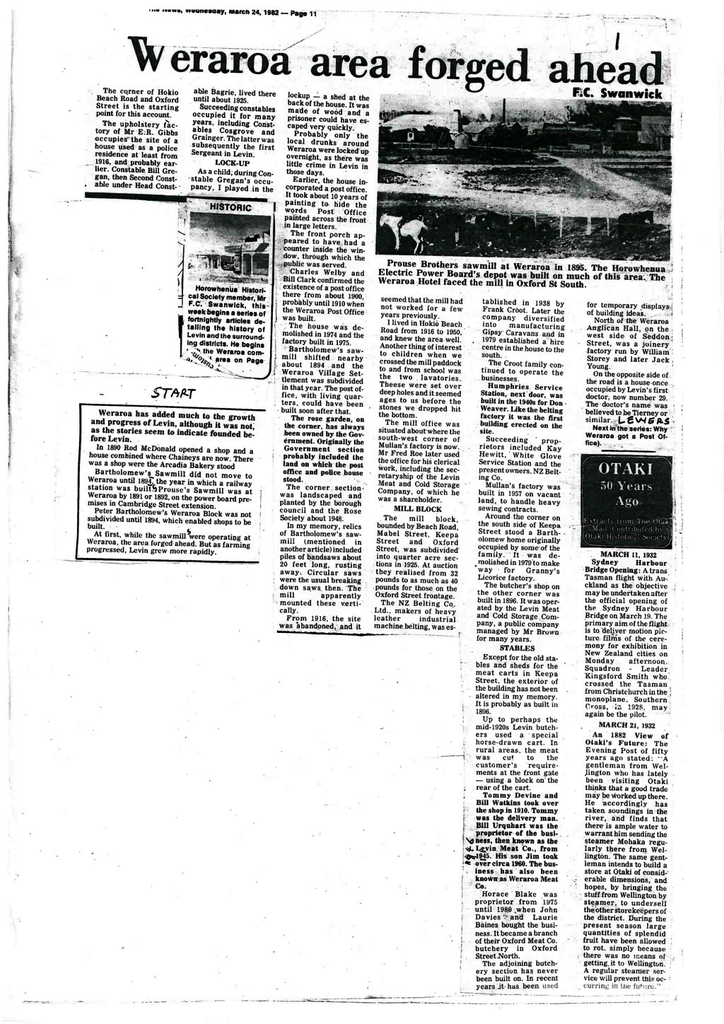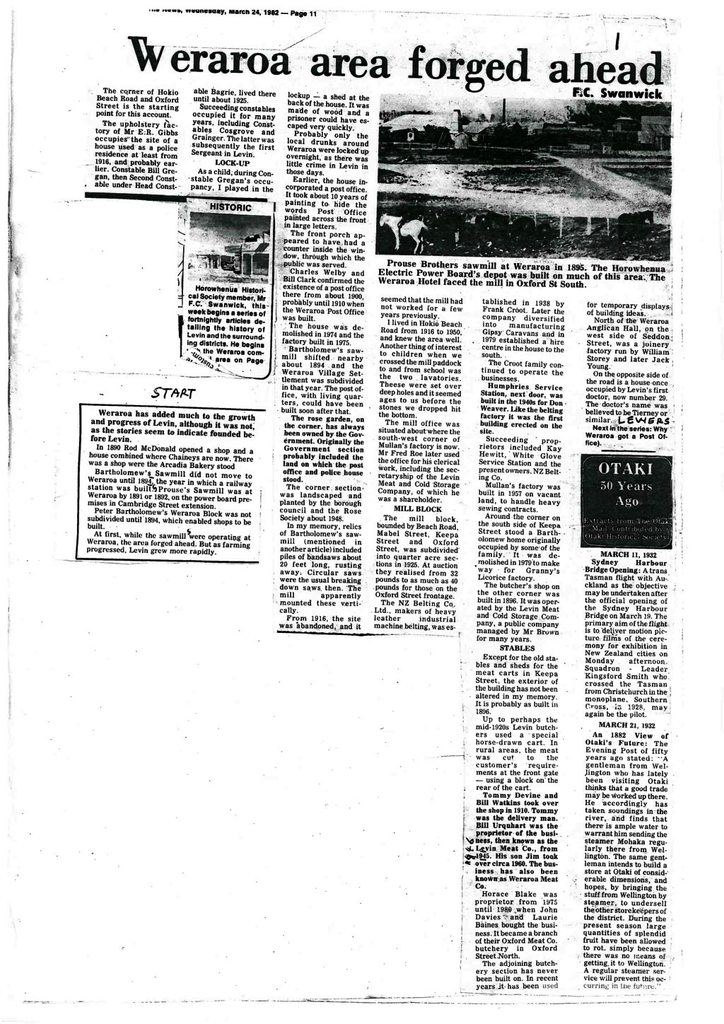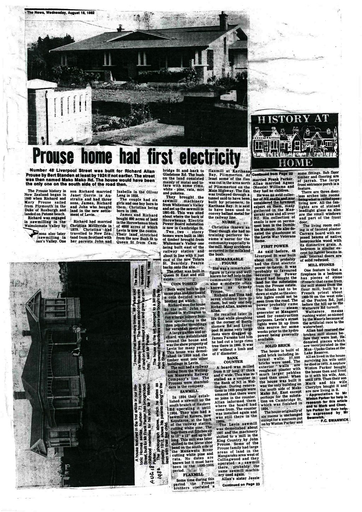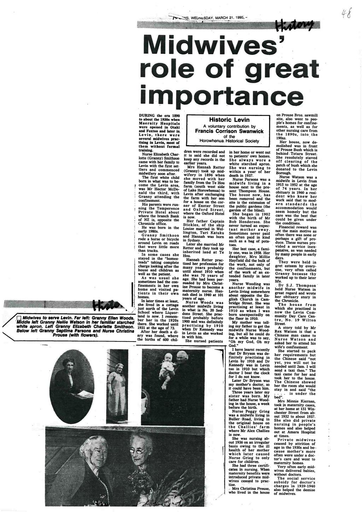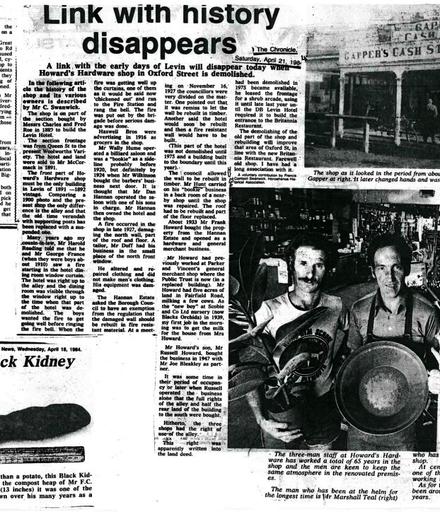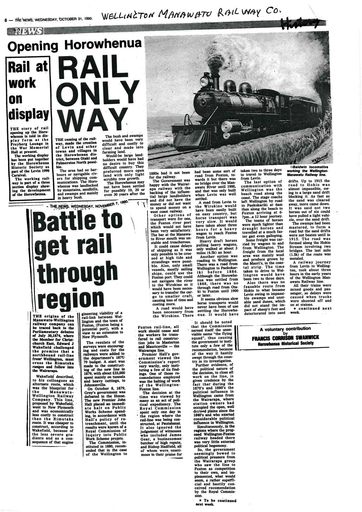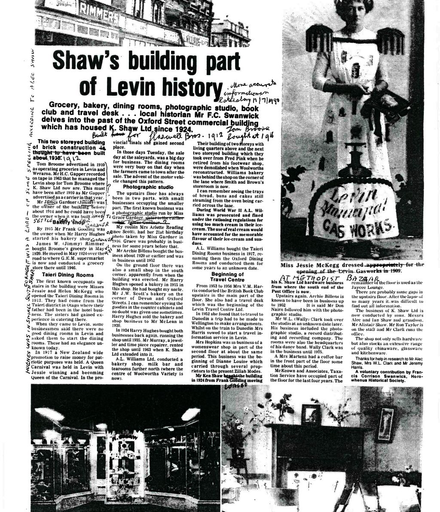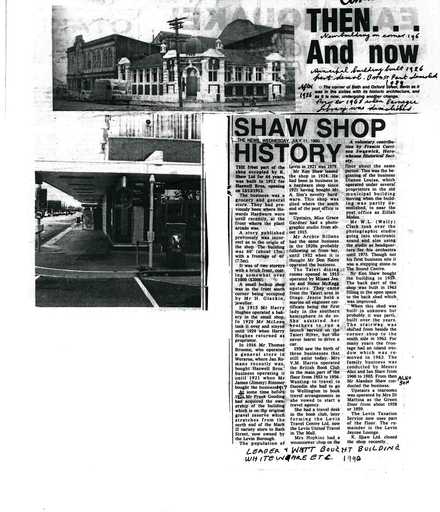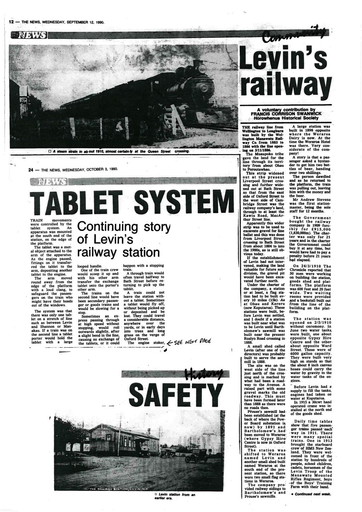In 1890 Rod McDonald opened a shop and a house combined where Chaineys are now. There was a shop where the Arcadia Bakery stood.
 Bartholomew’s Sawmill did not move to Weraroa until 1895, the year in which a railway station was built. Prouse’s Sawmill was at Weraroa by 1891 or 1892, on the power board premises in Cambridge Street extension.
Bartholomew’s Sawmill did not move to Weraroa until 1895, the year in which a railway station was built. Prouse’s Sawmill was at Weraroa by 1891 or 1892, on the power board premises in Cambridge Street extension.
Peter Bartholomew’s Weraroa Block was not subdivided until 1894, which enabled shops to be built.
At first, while the sawmills were operating at Weraroa, the area forged ahead. But as farming progressed, Levin grew more rapidly.
The corner of Hokio Beach Road and Oxford Street is the starting point for this account.
The upholstery factory of Mr E.R.Gibbs occupies the site of a house used as a police residence at least from 1916, and probably earlier. Constable Bill Gregan, then Second Constable under Head Constable Bagrie, lived there until about 1925.
Succeeding constables occupied it for many years, including Constables Cosgrove and Grainger. The latter was subsequently the first Sergeant in Levin.
Lock-Up
As a child, during Constable Gregan’s occupancy, I played in the lockup – a shed at the back of the house. It was made of wood and a prisoner could have escaped very quickly.
Probably only the local drunks around Weraroa were locked up overnight, as there was little crime in Levin in those days.
Earlier, the house incorporated a post office. It took about 10 years of painting to hide the words Post Office painted across the front in large letters.
The front porch appeared to have had a counter inside the window, through which the public was served.
Charles Welby and Bill Clark confirmed the existence of a post office there from about 1900, probably until 1910 when the Weraroa Post Office was built.
The house was demolished in 1974 and the factory built in 1975.
Bartholomew’s sawmill shifted nearby about 1894 and the Weraroa Village Settlement was subdivided in that year. The post office, with living quarters, could have been built soon after that.
The rose garden, on the corner, has always been owned by the Government. Originally the Government section probably included the land on which the post office and police house stood.
The corner section was landscaped and planted by the Borough Council and the Rose Society about 1948.
In my memory, relics of Bartholomew’s sawmill (mentioned in another article) included piles of bandsaws about 20 feet long, rusting away. Circular saws were the usual breaking down saws then. The mill apparently mounted these vertically.
From 1916, the site was abandoned, and it seemed that the mill had not worked for a few years previously.
I lived in Hokio Beach Road from 1916 to 1950, and knew the area well. Another thing of interest to children when we crossed the mill paddock to and from school were the two lavatories. These were set over deep holes, and it seemed ages to us before the stones we dropped hit the bottom.
The mill office was situated about where the south-west corner of Mullan’s factory is now. Mr Fred Roe later used the office for his clerical work, including the Secretaryship of the Levin Meat and Cold Storage Company, of which he was a shareholder.
Mill Block
The mill block, bounded by Beach Road, Mabel Street, Keepa Street and Oxford Street, was subdivided into quarter acre sections in 1925. At auction they realised from 32 pounds to as much as 40 pounds for those on the Oxford Street frontage.
The NZ Belting Co. Ltd., makers of heavy leather, industrial machine belting, was established in 1938 by Frank Croot. Later the company diversified into manufacturing Gipsy Caravans and in 1979 established a hire centre in the house to the south.
The Croot family continued to operate the businesses.
Humphries Service Station, next door, was built in the 1940s for Don Weaver. Like the belting factory it was the first building erected on the site.
Succeeding proprietors included Kay Hewitt, White Glove Service Station and the present owners, NZ Belting Co.
Mullan’s factory was built in 1957 on vacant land, to handle heavy sewing contracts.
Around the corner on the south side of Keepa Street stood a Bartholomew home originally occupied by some of the family. It was demolished in 1979 to make way for Granny’s Liquorice factory.
The butchers’s shop on the other corner was built in 1896. It was operated by the Levin Meat and Cold Storage Company, a public company, managed by Mr Brown for many years.
Stables
Except for the old stables and sheds for the meat carts in Keepa Street, the exterior of the building has not been altered in my memory. It is probably as built in 1896.
Up to perhaps the mid-1920s Levin butchers used a special horse-drawn cart. In rural areas, the meat was cut to the customer’s requirements at the front gate – using a block on the rear of the cart.
Tommy Devine and Bill Watkins took over the shop in 1910. Tommy was the delivery man. Bill Urquhart was the proprietor of the business, then known as the Levin Meat Co., from 1946. His son Jim took over circa 1960. The business has also been known as Weraroa Meat Co.
Horace Blake was proprietor from 1975 until 1989 when John Davies and Laurie Baines bought the business. It became a branch of their Oxford Meat Co. butchery in Oxford Street North.
The adjoining butchery section has never been built on. In recent years it has been used for temporary displays of building ideas.
North of the Weraroa Anglican Hall, on the west side of Seddon Street was a joinery factory run by William Storey and later Jack Young.
On the opposite side of the road is a house once occupied by Levin’s first doctor, now number 29. The doctor’s name was believed to be Lewers or similar.

